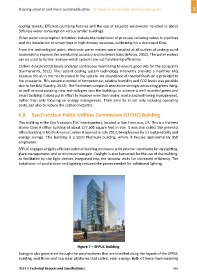Page 491 - Shaping smarter and more sustainable cities - Striving for sustainable development goals
P. 491
cooling towers. Efficient plumbing fixtures and the use of recycled wastewater resulted in about
50% less water consumption versus similar buildings.
Other water consumption initiatives include the installation of pressure reducing valves in pipelines
and the installation of sensor taps in high‐density locations, calibrating for a decreased flow.
From the technological point, electronic water meters were installed at all outlets of underground
reservoirs to improve the monitoring accuracy and to detect leaks (Infosys, 2012). The water meters
can be used to further analyse which systems are not functioning efficiently.
Carbon dioxide (CO2) levels undergo continuous monitoring to ensure good IAQ for the occupants
(Kurmananth, 2012). The radiant cooling system technology inherently provides a healthier IAQ
because the air is not re‐circulated in the system. An abundance of treated fresh air is provided to
the occupants. This accurate control of temperature, relative humidity and CO2 levels was possible
due to the BAS (Sarstry, 2012). The Pocharam campus is seen to be strongly advocating green living,
as well as incorporating new technologies into the buildings to achieve a well‐rounded green and
smart building. It does put in effort to improve even their water, waste and well‐being management,
rather than only focusing on energy management. Their aims lie in not only reducing operating
costs, but also to reduce the carbon footprint.
6.8 San Francisco Public Utilities Commission (SFPUC) Building
This building is the San Francisco PUC headquarters, located in San Francisco, CA. This is a thirteen
storey Class A office building of about 277,500 square feet in size. It was also called 'the greenest
office building in North America', when it opened in July 2012, being known for its sustainability and
energy savings. This building is a LEED Platinum building, where it houses approximately 950
employees.
SFPUC engages a highly efficient exterior building enclosure with exterior sunshades for daylighting,
glare management, and to minimize heat gain. Daylight is also harvested for the use of the building,
as facilitated by the light shelves integrated into the window walls for increased efficiency. The
installation of workstation task lighting reduced the power needed for additional lighting.
Figure 7 – SFPUC Building
Energy is also generated through the wind turbines that are installed along the façade of the SFPUC
building, and three roof top solar platforms that collect solar energy. Both of these have metering
ITU‐T's Technical Reports and Specifications 481

